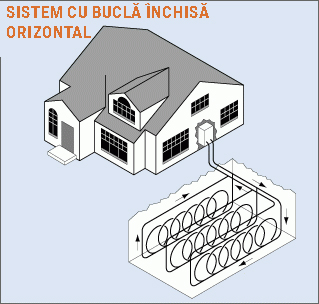The earth - through the hot rocks and fluids in the earth's crust - is a source of renewable energy that can be used for heating and electricity generation. The use of high-temperature water from aquifers is now more widely known to the general public, partly because there are areas in Romania where heating is already being carried out using this technology, namely the municipalities of Oradea and Beiuș. Beiuș is the town with the lowest heating prices in Romania. In today's article, we will briefly talk about another system of geothermal exploitation, the one called with closed loop (closed-loop), a promising technology that exploits the high temperatures of the rock layers in the earth's crust.
-
- What does the closed-loop system involve?
The use of the closed-loop system to obtain heat for heating and electricity generation requires:
-
- Deep drilling. These are very deep, several thousand metres, near the magmatic rock layer, where temperatures reach around 300°C.
- Introduction of pipelines made of a thermally conductive material in the ground.
- Ground heat capture. Similar to a radiator through which water is recirculated, the piping system captures heat and brings it to the surface as a hot liquid, which is then converted in the CHP plant into both electricity and heat.


Image source: energy.gov
-
- How is it different from the traditional open-loop system?
Simply put, the open-loop system works like this:
-
- Groundwater is taken from a nearby aquifer* (it is extracted from an underground water deposit at high temperatures).
- East water directed to a geothermal heat pump indoor.
- East water evacuated back through a well or is directed to a pond or drainage ditch, according to local regulations.
This system has 2 limitations, which the closed loop system circumvents:
-
- For traditional (open loop) geothermal applications, the water resource, i.e. the hot water reservoir, must be close to a district or industrial heating supplier.
- Conventional geothermal systems only work where geothermal gradients** are high.
Image source: energy.gov
-
- What are the benefits of using the closed loop system?
The closed-loop system offers several benefits over other geothermal exploitation systems:
-
- does not use natural resources as it does not extract hot (geothermal) water from underground.
- does not require pumping devices, as the hot liquid is returned to the surface by natural thermosiphon***.
- does not use hydraulic fracturing, so there is no risk of induced seismicity.
- no carbon dioxide or greenhouse gases are released.
- operating costs are lower than for traditional geothermal systems.
- is scalable, being less dependent on certain geological conditions than open-loop technology.
-
- Is this system new?
Yes, this technology is new, it has not yet been used in Romania, but it has been tested and developed in Canada, USA and Germany.
In Canada, the test loop has been in operation since 2019, while in Germany (Geretsried project), drilling operations are still ongoing.
-
- Is there legislation in Romania regulating this technology?
Large-scale use and exploitation of geothermal energy is subject to the Mining Law 85/2003.
Through revision, it could provide support for the development of closed-loop technology. Among the improvements needed are:
-
- Clearer definition of geothermal energy;
- Expanding terminology, adapted to new technologies;
- Simplify authorisation processes.

-
- Why is it important for Romania to develop closed-loop projects?
Closed-loop technology offers some important benefits for our country:
-
- is a safe and clean source of energy at competitive prices. A single system can be used to heat 16 000 homes.
- requires significant investment that contributes to economic growth. It leads to the creation of new jobs.
- the impact on the environment, soil, noise and air quality is very low.
-
- Is geothermal energy expensive?
As with other modern technologies, geothermal energy requires a significant investment for development. However, operating costs are lower and the investment is covered over time.
*aquifer = water-bearing horizon consisting of a geological formation in which water has accumulated and which can transmit water in sufficient quantities to serve as a source of food. (Source: Morar, Florica - Explanatory Dictionary - Earth Sciences, Ioan Ionescu de la Brad Publishing House, 2015)
** geothermal gradient = temperature variation with depth
*** natural thermosiphon: the hot liquid has a specific weight that allows it to rise through the outlet pipe.






